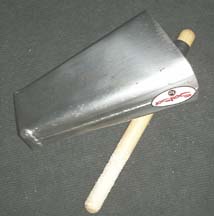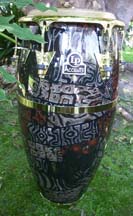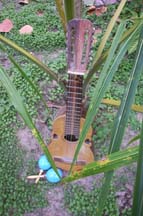 |
 |
 |
 Entertainment | June 2005 Entertainment | June 2005  
Latin Music Rhythms
 danieldelosreyes.com danieldelosreyes.com


| DRUMJUNGLE is an innovative company established by internationally renowned percussionist Daniel de los Reyes to bring you the world's best musicians and custom designed equipment.
Click HERE to visit the website. |
Latin music awakens our senses with its upbeat and romantic dance rhythms. To assist those unfamiliar with this style of music, we have compiled an alphabetical list of the most common Latin musical rhythms followed by an easy-to-understand definition.

CHA-CHA-CHA: A Cuban style of music created from the Cuban Danzon in the early 1950s and made popular by Jose Fajardo, Enrique Jorrin, and Arragon y sus estrellas.

COCO: This rhythm is a blend from Northeastern Brasil with a Caribbean flavor with the percussion ensemble playing the Coco rhythm on variety of drums such as surdo, congas, bells, and cuicas.

CONGAREDA: The congareda is a new rhythm created by combining the Cuban Carnaval parade rhythm the conga with the Brasilian Ze Pereira marching rhythm. The main instruments are the Timbau conical shaped drum played like a conga drum and the surdos.

DESCARGA: An instrumental improvisation or jam session allowing complete creative freedom between musicians.

GUA-GUAN-CO: One of the medium tempo Rumbas. (For a more complete description, see Rumba)

MAMBO: A style of Cuban music made popular in the late 1940s and early 50s which was inspired by such artists as Antonio Arcano, Israel Lopez, and Perez Prado.

MARACATU: The rhythm Maracatu baque virado is from Recife in the Northern part of Brasil. Its is an old traditional style of drumming, song, and dance with African origins dating back to the 1800. The main instruments are the bass drum-surdo, caixa-snare drum, and the agogo.

PACHANGA: A Cuban style of music made famous in the late 1950s and early 60s. The Pachanga dance craze took off like wildfire in New York City. When the Tito Rodrigues orchestra performed Pachanga at the Palladium, you could literally feel the building tremble.

RUMBA: There are three forms of Rumbas: Gua-guan-co, Yambu, and Columbia. The Rumba is an Afro-Cuban musical form comprised of drumming, call-and response vocals, and dancing.

RUMBEROS: Dancers, singers, or drummers associated with Rumba.

SON: The Son is the most influential Cuban style of music dating back at least two centuries. The heart and soul of Son music is African but it has evolved over the years with the influences of Spanish elements of the cancion style.

Latin Music Instruments

To assist those unfamiliar with the sensuous and danceable rhythms of Latin music, we have compiled an alphabetical list of the most common Latin percussion instruments with a photograph and easy-to-understand definition.


AGOGO: The agogo is a double coned shaped bell attached by a metal rod. Many Brasilian rhythms like the samba use this two tone bell during Carnaval celebrations. |

BATA: A bata is a somewhat hourglass shaped Nigerian wooden drum that is strapped around your legs and then played on your lap. It is frequently used in Cuban music as well as many religious ceremonies. |

BONGO: A pair of small connected drums of different sizes that are tuned high in pitch and held between your legs to play. |

CAJON: A box made of wood that is placed between your legs and played with your hands in a similar motion as a bongo. Originally the resonant wooden crates of various sizes were used to play the early forms of Rumba. |

CAMPANA: Also known as a cowbell, this term is used for the hand bell played by the bongo player. |

CLAVE: A pair of wooden or plastic sticks used to play the clave rhythm by striking them together. The clave rhythm is one of four two-bar rhythms serving as the foundation to Afro-Cuban music today. |

CONGA: Also called Tumbadoras, the barrel-shaped, single headed, hollowed drums with cowhide or plastic heads are now made of wood and fiberglass. The Conga is also a Cuban dance rhythm that is traditionally danced during carnival times. |

CUATRO: A four doubled string guitar which is typically used in Puerto Rican music. | | 
 | |
 |



